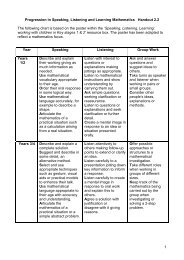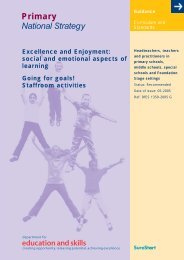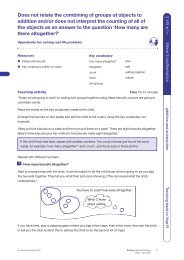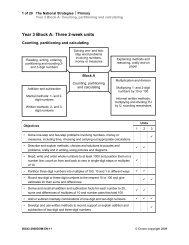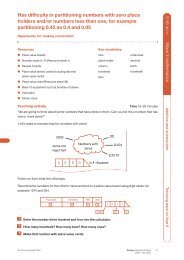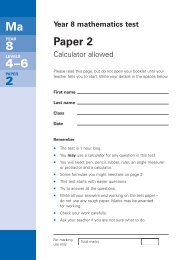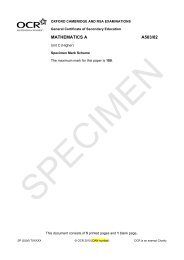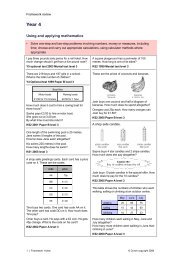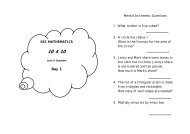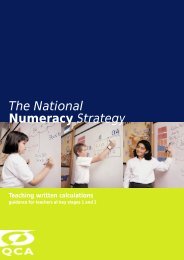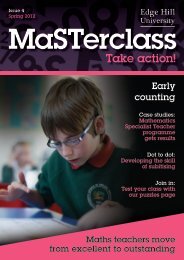Unit 2 - Dudley Virtual Resource Centre
Unit 2 - Dudley Virtual Resource Centre
Unit 2 - Dudley Virtual Resource Centre
- No tags were found...
You also want an ePaper? Increase the reach of your titles
YUMPU automatically turns print PDFs into web optimized ePapers that Google loves.
<strong>Unit</strong> 2Place valueFive daily lessonsYear 2Autumn term<strong>Unit</strong> ObjectivesYear 2• Count on or back in ones or tens, starting from any given twodigitnumber.• Read and write whole numbers to at least 100 in figures andwords.• Know what each digit in a two-digit number represents,including 0 as a placeholder and partition two-digit numbers into amultiple of ten and ones (TU).• Say the number that is 1 or 10 more or less than any given two-digitnumber.• Order whole numbers to at least 100, and position them on anumber line and 100 square.Link ObjectivesYear 1 Year 3• Count on and back in ones from any smallnumber, and in tens from and back to zero.• Read and write numerals from 0 to at least 20.• Begin to know what each digit in a two-digitnumber represents. Partition a ‘teens’ numberand begin to partition larger two-digit numbersinto a multiple of ten and ones (TU).• Within the range 0 to 30, say the number thatis 1 or 10 more or less than any givennumber.• Order numbers to at least 20, and position on anumber trackPages 3, 5, 7Page 9Page 9Page 13• Count on or back in tens or hundreds,starting from any two- or three-digit number.• Read and write whole numbers to at least1000 in figures and words.• Know what each digit represents, and partitionthree-digit numbers into a multiple of 100, amultiple of ten and ones (HTU).• Say the number that is 1, 10 or 100 more orless than any two- or three-digit number.• Order whole numbers to at least a 1000, andposition them on a number line.This <strong>Unit</strong> Plan is designed toguide your teaching.You will need to adapt it tomeet the needs of your class.<strong>Resource</strong>s needed to teach this unit:• OHT 2.1• Activity sheet 2.1• Activity sheet 2.2• Activity sheet 2.3• Activity sheet 2.4• Activity sheet 2.5• Activity sheet 2.6• Bead string (100) and tags to hang on it(e.g. squares of card attached to paperclips)• Class set of 0-9 dice• Hundred square• Tin• Real 10p and 1p coins• Mega money (large coins)• WhiteboardsSee also Models and Images Charts:• Counting on and back in ones and tens;• Ordering numbers to 100;• Partitioning and recombining.(Key objectives in bold)PNS <strong>Unit</strong> Plans
PlanningDay Three <strong>Unit</strong> 2 Place value Term: Autumn Year Group: 2sheetOral and Mental Main Teaching PlenaryObjectives andVocabularyCount on in ones,twos and tens fromzero to 100 andback again.VOCABULARYonestwosevenoddtensTeaching Activities• Give the children a start number and ask them tocount quickly in ones, forwards and backwards.Repeat this time counting in twos, first withclapping and then without as on Day 2.• Give the children an even number and countforwards in twos. Tell children that as they countthey are to clap on every tens number, as they saythat number. Repeat with other even startingnumbers. Stop the class at 46 say and ask:Q Which two even numbers does the number 40lie between?Collect answers on whiteboards. Repeat countingforwards and backwards and discuss the positionsof the tens numbers.Q If we start with an odd number and count intwos, will we get tens numbers to clap on?Discuss children’s views and confirm by countingthat no tens numbers are included in the count.• Tell children that you are going to drop 10p coinsinto a tin and you want them to listen carefully andtell you how much money is in the tin.Ask the children to count in tens as you drop thecoins in, up to 100p.Q How else can we say 100p?If we have 50p in the tin and drop another 10pcoin in, how much will we have then? And if weadd two 10p coins?Collect answers and discuss strategies.Objectives andVocabularyPartition two-digit numbersinto a multiple of 10 andones.Order numbers in thecontext of money.VOCABULARYonestenspenniespencecoinstwo-digit numberplace valuemultiplesTeaching Activities• Write prices which are multiples of ten on the boarde.g. 60p.Q What does this number say? How many 10p coins doyou need to make this amount? How do you know?• Write other two-digit prices on the board such as 21p,35p etc.Invite children to make the amounts using the Megamoney 10p and 1p coins.Q How many tens did you use and how many ones didyou use?• Give each pair a copy of Activity sheet 2.3 of toy jumblesale prices and Activity sheet 2.4.Demonstrate how to play ‘Spend Spend Spend’ in pairsin this way:In turn, children decide which toy to claim and cross offthe correct number of 10p coins and 1p coins on thesheet. They play until they do not have enough moneyon the sheet to buy any more toys. They should thenwrite how much money they have left.Q Which toy needs the most 10p coins to pay for it?Which needs the most pennies?Teaching Activities/ FocusQuestions• Invite children to show their favouritetoy.Q How many tens and ones did youhave to cross off to get it?Q Which is the most expensive?Which digit helps you decide this?Which is the cheapest? Which digithelps you decide?Which is more, 29p or 92p? Why?Q How much money did you have left?How did you know that you couldn’tbuy anything else?Q If we could use coins other than 10pand 1p coins, which toy could wepay for using just one coin?By the end of the lesson, childrenshould be able to:• partition two-digit numbers into amultiple of 10 and ones;• exchange up to 100 pennies for10p and 1p coins;• decide which amount of money ismore or less.(Refer to supplement of examples,section 5, pages 9, 15.)RESOURCESWhiteboardsTin10p coins• Repeat counting on and back in tens from differenttens numbers.RESOURCESMega money (large coins)Activity sheet 2.3Activity sheet 2.4PNS <strong>Unit</strong> Plans
PlanningDay Four <strong>Unit</strong> 2 Place value Term: Autumn Year Group: 2sheetOral and Mental Main Teaching PlenaryObjectives andVocabularyCount on or back inones, twos and tens.VOCABULARYcount oncount backonestwostensRESOURCESClass hundred squareTeaching Activities• On the board write the numbers:1 2 10Give children a start number e.g. 23. Say you wantthem to count forwards from 23 and you will point tothe number on the board to show the steps that theyare to count in. Start with ones and move to twos andtens, and then keep changing the size of the step. Atthis stage, keep the counting in tens to the tensnumbers e.g.23, 24, 25, 26, 28, 30, 40, 50, 52, 54, 55 etc.Repeat with different starting numbers, and askchildren to count backwards.• Remind children that they have been counting in tens,using only the tens numbers.Q If we counted on from 23 in tens, what would thenext two numbers be?Collect answers on whiteboards and discuss patternsin the digits. Repeat with other starting numbers.Include different units digits e.g. 42, 69 and askchildren to count forwards and backwards in tens.• Refer to a displayed hundred square. Point tonumbers on the square as they count in tens to helpthe children see and use the patterns.• Tell the children that you want them to count in ones,twos and tens forwards and backwards.Explain that you will point to the number on the boardas before, this time saying forwards or backwards toidentify the direction of the count. Give children astart number e.g. 55 and generate a count such as:55, 56, 57, 67, 77, 76, 75, 74, 72, 70.Include counting in tens from a variety of two-digitnumbers. Start slowly but encourage the children tobuild up speed gradually as they become moreconfident.Objectives andVocabularyKnow what each digit ina two-digit numberrepresents.Say the number that isone or ten more or lessthan a given two-digitnumber.VOCABULARYgroups of tenonestensdigitaddsubtractRESOURCESBead stringClass hundred squareActivity Sheet 2.5PNS <strong>Unit</strong> PlansTeaching Activities• Remind the children that when we count on in tens, we are adding 10each time, and that when we count back in tens we are subtracting 10time. Show this on the bead string.Slide another 10 beads along the string to join the 23.Q How many beads do we have now? How do we write that number?How many groups of ten? How many ones? Which digit haschanged? Which digit would change if we added another 10?Another 1?Ascertain that adding 10 changes the tens digit only. Adding 1 usually onlychanges the ones digit.Q Can you think of a number that changes both its tens digit and onesdigit when you add one to it? What is the ones digit?Agree that this will happen if the ones digit is 9.• Ask a child to find 23 on the hundred square.Q What is 23 + 10? Where is the answer on the hundred square?What is 23 + 1? Where is the answer on the hundred square?• Show 45 beads on the bead string. Slide 10 beads back to leave 35beads.Q What has happened this time? How many beads are left? Which digithas changed? Which digit would change if we subtracted another 10beads? What if we subtracted one bead? When would both digitschange?Agree that both digits would change when subtracting one from a numberending in zero.• Ask a child to find 35 on the hundred square.Q What is 35 – 10? Where is the answer on the hundred square?What is 35 – 1? Where is the answer on the hundred square?• Write the following two-digit numbers on the board:42, 75, 84, 61, 79, 50, 30.Ask the children to choose at least four numbers. They should add andsubtract 1, and then add and subtract 10 to and from each of their fournumbers recording the number sentences like this:e.g. 42 + 1 = 43 42 + 10 = 52 42 – 1 = 41 42 – 10 = 32Teaching Activities/ FocusQuestions• Discuss the effect of addingsubtracting 1 and 10.Q When you added 1, whichnumber changed both itsdigits? Why?Which number changedboth its digits when yousubtracted 1? Why?• Say that a chocolate bar costs32p.Q If the price increases by 1p,what will the new price be?If it increased by 10p whatwould the new price be? Ifthe new price was 1p less,what would it be? If it was10p less what would it be?HOMEWORK – Give out Activitysheet 2.5, read through theinstructions and ask the children toplay the game with someone athome.By the end of the lesson,children should be able to:• recognise what each digitin a two-digit numberrepresents;• respond to questionssuch as, ‘what is 1 morethan 53? What is 10 lessthan 78?’(Refer to supplement ofexamples, section 5, pages 9,13.)
PlanningDay Five <strong>Unit</strong> 2 Place value Term: Autumn Year Group: 2sheetOral and Mental Main Teaching PlenaryObjectives andVocabularyCounting in ones,twos and tens.Teaching Activities• Write on the board:1 2 10Ask class to count forwards andbackwards as on day 4 in stepsof 1, 2 and 10. Have a hundredsquare displayed as before.• At various points stop the counte.g. 44 and ask:Q What number will we get if wecount on two 10s and a 2?Collect answers on whiteboardsand discuss children’s solutionsand strategies. Repeat countingfrom different starting points andasking similar questions.Include both forwards andbackwards counts. Stop atvarious numbers e.g. 61 and askquestions such as:Objectives andVocabularySay the number that isone or ten more or lessthan a given two-digitnumber.Position numbers on ahundred square.Teaching Activities• Say that you are thinking of a number on the hundred square. Make surethat all the children can see the hundred square.Q When you add 1 to this number the answer is 36. When you take away 1the answer is 34. When you add 10 to my number you get 45. Whenyou subtract 10 from my number you get 25. What’s my number?• Repeat with other two-digit numbers, asking children to secretly write downthe number in their books when they’ve guessed it.• Draw a cross shape on the board (like the one on the sheet with 46 in thecentre) and write 35 in the middle.Q If this were part of hundred square, what number would go after 35 to theright? How do we work that out? What number would come before it?Above it? Below it? How do we work out what these missing numbersare?• Give out Activity sheet 2.6: segments from a hundred square. Ask childrento complete as many of the pieces as possible without looking at ahundred square.Teaching Activities/ FocusQuestions• Draw the following shape on the board:35Q What numbers might go in the otherboxes? How could we work them out?• Discuss each square in turn, and whatneeds to be added/subtracted, e.g.adding 10 and 1 produces the number inthe bottom right-hand corner.• Draw the calculations on a number line,e.g.+10+1VOCABULARYonestwostensforwardsbackwardsRESOURCESClass hundredsquareQ What number will we get if wecount backwards three 10sand forwards 2?• Tell the children that this timeyou want them to count withoutthe help of the hundred square.Hide the square and get theclass to count, stop and askquestions as before andencourage them to imagine thehundred square if it helps them.VOCABULARYonestenshundredstwo-digit numbermorelessRESOURCESClass hundred squareActivity sheet 2.6or35 45 46+10+135 4656By the end of the lesson, childrenshould be able to:• use their knowledge ofadding/subtracting 1 or 10 to fillin missing numbers on a hundredsquare.(Refer to supplement of examples,section 5, pages 13, 15).PNS <strong>Unit</strong> Plans
Year 2 <strong>Unit</strong> 2 (Autumn term) Activity sheet 2.1PNS <strong>Unit</strong> Plans
Year 2 <strong>Unit</strong> 2 (Autumn term) Activity sheet 2.223 = 20 +34 = 30 +27 = + 744 = + 4= 30 + 4= 50 + 5PNS <strong>Unit</strong> Plans
Year 2 <strong>Unit</strong> 2 (Autumn term) Activity sheet 2.333p86p65p76p43p99p24p50p15p42pPNS <strong>Unit</strong> Plans
Year 2 <strong>Unit</strong> 2 (Autumn term) Activity sheet 2.4PNS <strong>Unit</strong> Plans
Year 2 <strong>Unit</strong> 2 (Autumn term) Activity sheet 2.6Complete these pieces from a hundred square15 424 25 14 43 44746527281 83 63 1954 9599PNS <strong>Unit</strong> Plans
Year 2 <strong>Unit</strong> 2 (Autumn term) Activity sheet 2.5Path to the EdgePlay this game in pairs. You will need a coin to toss and two differentlycoloured pens. One person marks 45 with a cross and the other marks 46with a cross in a different colour. Take it in turns to toss the coin. If it landsheads side up, you can either add 1 or 10. If it lands tails side up, you caneither subtract 1 or 10. When you’ve worked out the answer, put a cross onthat square and start with that number next time.The winner is the first person to reach one of the four sides of the hundredsquare.1 2 3 4 5 6 7 8 9 1011 12 13 14 15 16 17 18 19 2021 22 23 24 25 26 27 28 29 3031 32 33 34 35 36 37 38 39 4041 42 43 44 45 46 47 48 49 5051 52 53 54 55 56 57 58 59 6061 62 63 64 65 66 67 68 69 7071 72 73 74 75 76 77 78 79 8081 82 83 84 85 86 87 88 89 9091 92 93 94 95 96 97 98 99 100PNS <strong>Unit</strong> Plans
Year 2 <strong>Unit</strong> 2 (Autumn term) OHT 2.1Number Line A (Beads)Number Line BPNS <strong>Unit</strong> Plans



